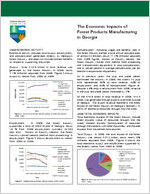The Economic Impacts of Forest Products Manufacturing in Georgia
2009 ECONOMIC ACTIVITY Economic activity includes total output, employment, and compensation generated directly by Georgia's forest industry, and does not include indirect benefits to related or supporting industries: Output - Over $16.9 billion in total revenue was generated by the forest industry in 2009; down 7.1% (inflation adjusted) from 2008. Figure 1 shows output by sector from 2004 to 2009.
Employment - In 2009, the forest industry supported a total of 48,519 jobs in Georgia; down 16 % from 2008 employment numbers (9,293 jobs lost). Across all industry sectors, the forest industry ranked second (behind food processing) in employment. Figure 2 shows employment by sector from 2004 to 2009.
Compensation - Including wages and benefits, jobs in the forest industry earned a total annual compensation of almost $2.8 billion; down 11.2% (inflation adjusted) from 2008 figures. Across all industry sectors, the forest industry ranked third (behind food processing and transportation equipment) in total compensation, and is ranked second in average compensation per job (behind transportation equipment).
As in previous years, the pulp and paper sector dominated the industry in 2009; the state's 12 pulp mills represented 65% of total revenue, 40% of employment, and 54% of compensation (figure 3). Despite a 9% drop in employment from 2008, revenue in the pulp and paper sector increased by 2%.
Of the $16.9 billion in total revenue in 2009, $14.5 billion was generated through exports to entities outside of Georgia. This export revenue represents the direct impact of the forest industry on Georgia's economy, in terms of additional resources brought into the state.
2009 TOTAL ECONOMIC IMPACTS Total economic impacts of the forest industry include direct impacts (value of resources brought into the state), indirect impacts (re-circulation of resources through transactions with other industries), and induced impacts from household consumption:
Total Output - In 2009, the total impact of the forest industry was almost $27.2 billion, down nearly 5% (inflation adjusted) from 2008. Figure 3 shows the total economic output and employment supported by the forestry sector from 2003 to 2009.
Total Employment - The forest industry supported 118,423 jobs across all sectors of Georgia's economy in 2009, down 7.8% from 2008 (9,965 jobs lost). Refer to Figure 4.
to-critically dependent on the forest industry based on both employment and income. Figure 6 and Table 1 show employment dependence by county in 2009.
Total Compensation - In 2009, the forest industry supported annual wages and benefits equal to nearly $5.6 billion, down 14.3% (inflation adjusted) from 2008.
Since 2007, total output supported by the forest industry has shrunk, trailing reductions in employment and compensation that began in 2006. In 2009, employment continued to shrink, but at a slower rate than 2007 or 2008 (Figure 5). Unfortunately, reductions in total compensation continued to increase in 2009.
LOCAL ECONOMIC DEPENDANCE The forest industry plays a vital role in supporting local economies and rural livelihoods throughout Georgia. The rural economies of 44 counties are moderately-
2009 FISCAL IMPACTS In 2009, the forest industry generated $472 million in tax revenue for the state of Georgia. Net revenue for 2009 from the forest industry (state revenues minus state costs) totaled over $158 million.
REFERENCE Raill, B.W. Economic Benefits of the Forestry Industry in Georgia: 2009. Enterprise Innovation Institute Report. Georgia Institute of Technology, 2010
